Even bread beginners can pull off this homemade focaccia recipe! Topped with olive oil, rosemary, and sea salt, it's SO delicious and easy to make.

This focaccia recipe is our favorite bread to bake at home. We love it because it’s soft and pillowy in the middle, crisp and golden around the edges, and filled with rich flavor from olive oil and sea salt. And that’s just the start! The #1 reason we love this focaccia recipe is that it’s so easy to make.
When Jack first started baking bread (15+ years ago now!), he made lots of rustic ciabatta loaves. The ingredients were simple, and the bread came out delicious, but it required hours of rising and precise kneading. So when we discovered how simple it is to make really good focaccia bread, we didn’t look back.
Now, this focaccia recipe is our go-to. We first published a version of it in my cookbook Love & Lemons Every Day and have since revised the recipe to yield an even lighter, crisper focaccia that we can never get enough of. It’s a wonderful recipe for bread beginners and seasoned bakers alike—simple, forgiving, and always delicious.
What is focaccia bread?
Focaccia (pronounced foh-KAH-chyuh) is an Italian style of bread. According to Essentials of Classic Italian Cooking by Marcella Hazan, it’s most closely associated with the northwestern Italian region of Liguria and its capital city Genoa.
You can recognize focaccia by its flat shape and characteristic dimpled surface. Made with an olive oil-enriched, salted dough, it might be baked plain or topped with vegetables, herbs, and/or cheese. Find some of my favorite toppings in the post below!
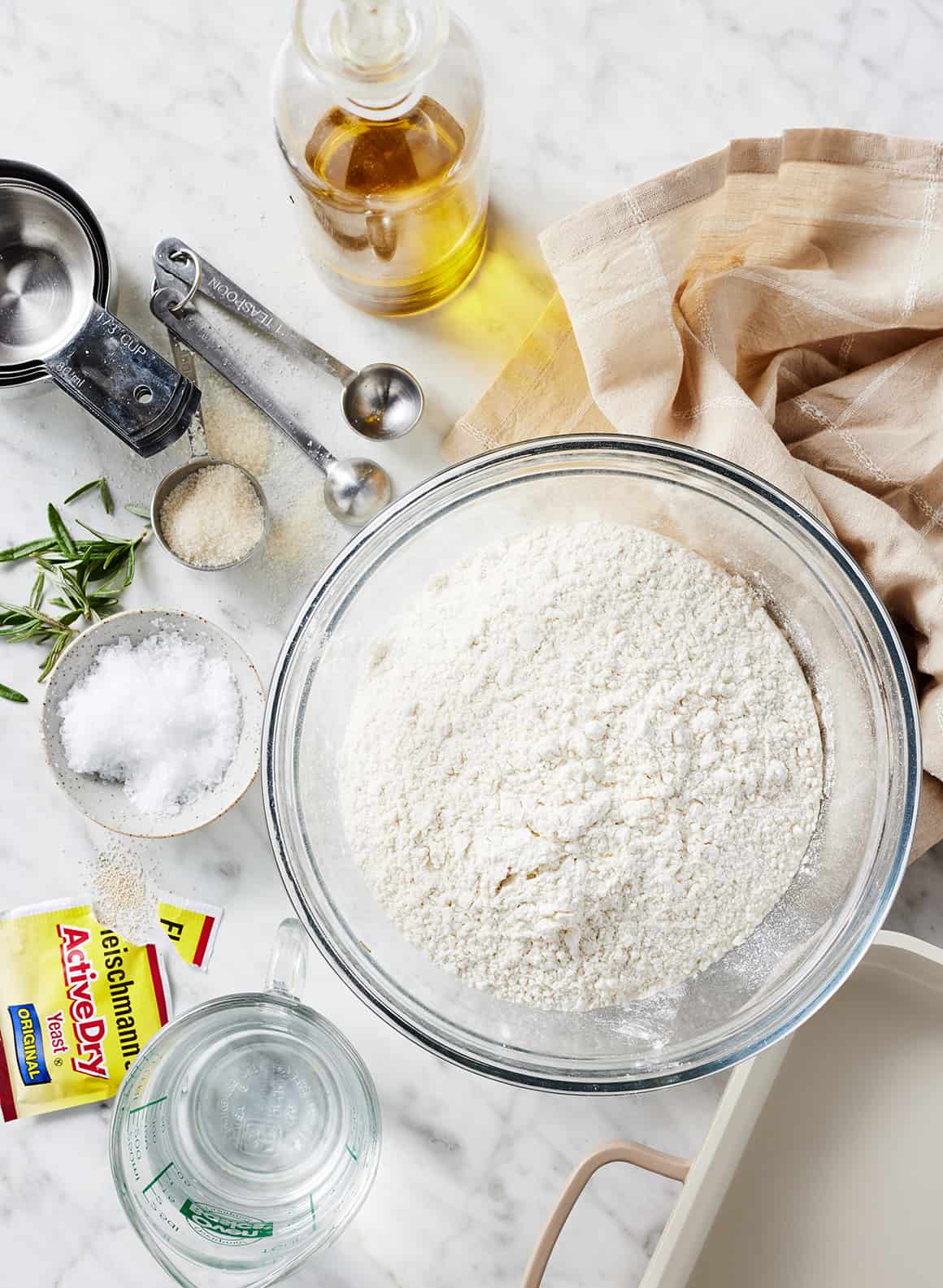
Focaccia Bread Ingredients
Ready to bake? Here’s what you’ll need to make this focaccia bread recipe:
- All-purpose flour – Flour is the main ingredient in this recipe, so measuring it as accurately as you can will serve you well. If you have a kitchen scale, now’s the time to use it! Weighing the flour will give you the most precise measurement. If you don’t have a scale, your next best bet is spooning and leveling the flour to avoid packing too much into your measuring cup.
- Warm water – It hydrates the dough. Heads up: The biggest change we’ve made to this recipe over the years is increasing the ratio of water to flour. The dough is very wet, but this high level of hydration gives the bread a wonderful airy texture inside!
- Active dry yeast or instant yeast – Proof it in the water with a little cane sugar before mixing up the dough.
- Extra-virgin olive oil – It adds rich flavor to the focaccia and makes its edges crisp and golden.
- Fresh rosemary – For topping. Find other topping suggestions below!
- Sea salt – Seasoned bread=flavorful bread. Mix fine sea salt into the focaccia dough. Before baking the loaf, sprinkle flaky salt on top!
Find the complete recipe with measurements below.

How to Make Focaccia Bread
The first step in this focaccia recipe is making the dough. Start by proofing the yeast. In the bowl of a stand mixer fitted with a dough hook, stir together the water and sugar. Stir in the yeast and set aside for 5 minutes, or until foamy. If the yeast doesn’t foam, discard the mixture and start again with new yeast.
When the yeast is foamy, add the flour and salt. Mix on low speed until a shaggy dough forms. Then, increase the speed to medium and mix for 5 minutes. The dough will become very sticky and elastic. It will begin grabbing the sides of the bowl.
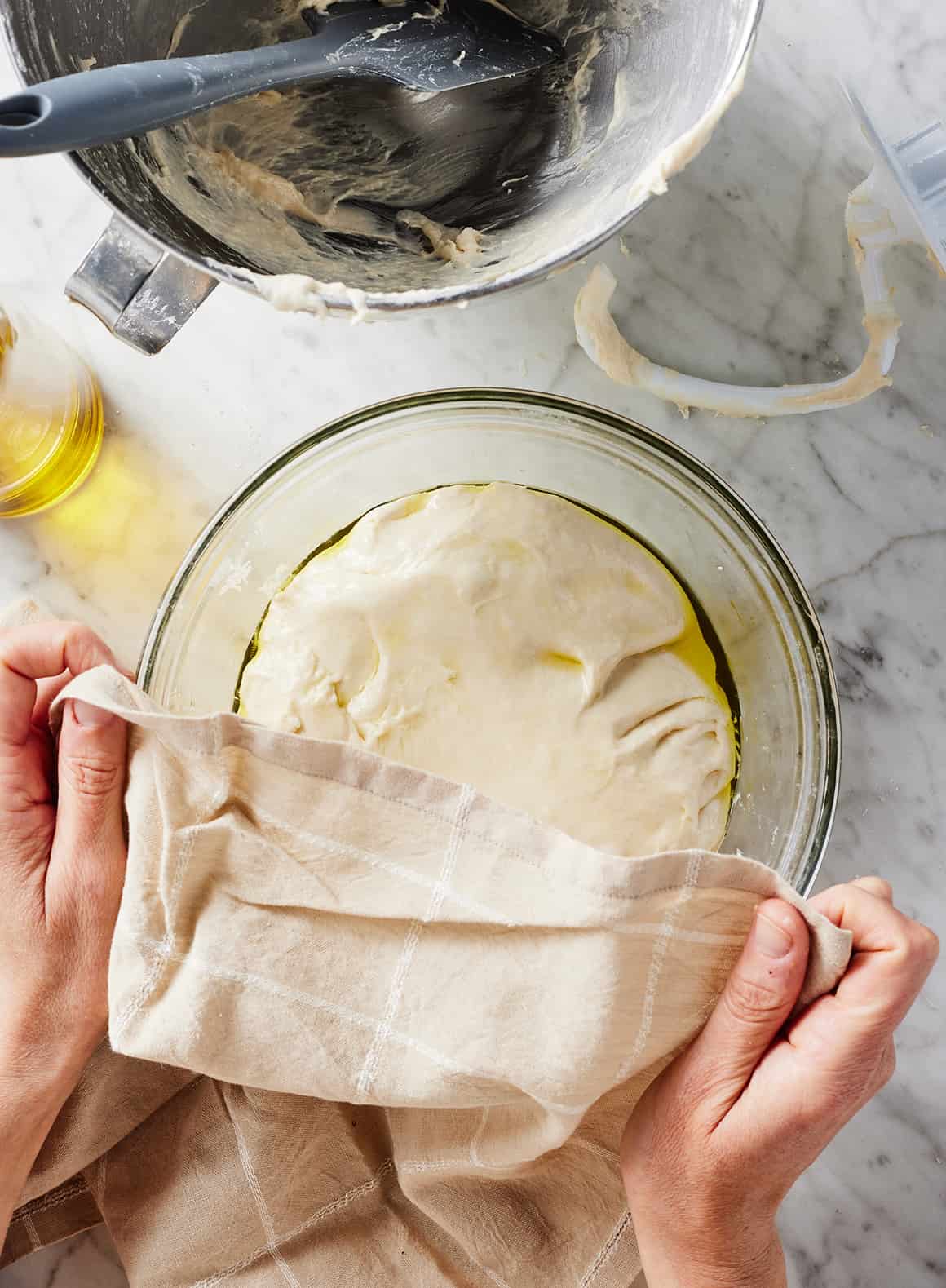
It’s time for the first rise! Brush a large bowl with 2 tablespoons of olive oil. Use a spatula to transfer the dough from the bowl of the stand mixer to the oiled bowl. It will be too sticky to transfer by hand!
Use your fingers to brush any oil that’s pooling around the edges of the dough over its surface. Cover with plastic wrap or a damp towel and set aside to rise until doubled in size, 1 to 1 1/2 hours.

Next, shape the focaccia. Brush a 9×13-inch pan with another 2 tablespoons of olive oil.
Tip
My favorite pan to use for this recipe is a nonstick aluminum 9×13-inch baking pan.
If your pan is not nonstick, I recommend greasing it with butter before adding the oil. It might seem excessive, but it’s essential for preventing the bread from sticking!
Uncover the dough and rub your hands with olive oil. Slide your hand under one edge of the dough and fold it into the center of the bowl. Continue working your way around the edge of the bowl, folding the dough into itself, until you have a rough ball that you can lift from the bowl (see above photo).
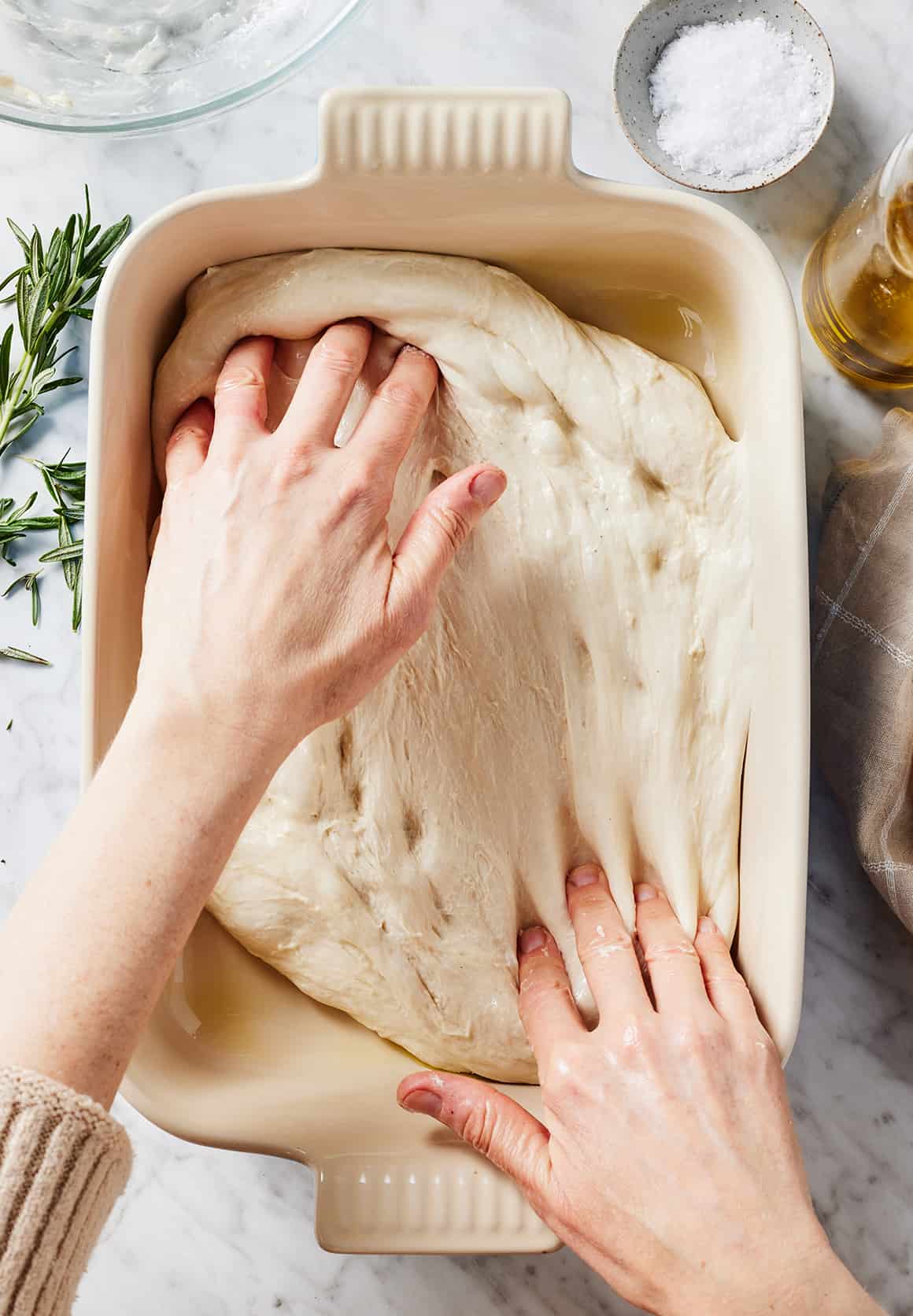
Transfer the dough to the prepared pan and turn to coat it in the oil.
Press the dough to the pan’s edges. Let it relax, and then press it to the edges again.
Let the dough rise for a second (shorter) time. Cover the pan and set it aside for 45 minutes, or until the dough has doubled in size. 30 minutes into this rise, preheat the oven to 425°F.

Dimple the dough. Uncover the focaccia and drizzle 2 more tablespoons of oil on top of the dough. Rub your hands with olive oil and use your fingers to make indentations across the surface of the dough. You don’t have to be gentle here! Press all the way through the dough to the pan. Some air bubbles should pop up in the process. That’s good! They brown beautifully in the oven.
Finally, top and bake. Add your desired toppings (flaky sea salt and rosemary are my go-tos!) and bake until the focaccia is golden brown, 20 minutes to 30 minutes.
Let cool slightly, and then slice and enjoy! You can’t beat warm focaccia bread.
Focaccia Recipe Tips
- Oil your hands. This recipe asks you to oil your hands often. It might seems unnecessary or repetitive, but it makes a HUGE difference. Focaccia dough is wet and sticky, and it will stick to your hands if they’re not oiled, making it really difficult to work with. So, please! Oil your hands liberally. Just think of it as a little extra moisturizer!
- Temperature affects rising time. I’ve given estimated times for each rise in this recipe, but the primary indicator of when to move on to the next step should be the size of the dough. It might take more or less time to double depending on the temperature of the place it’s rising. Generally, the warmer dough is, the faster it rises. If it’s cold, it rises more slowly.
- Freeze the extras. Homemade focaccia is best on the day it’s made, but it will keep well in an airtight container at room temperature for up to 3 days. If you’d like to have it on hand for longer, I recommend freezing it. It thaws and reheats nicely!

Recipe Variations
Most often, I make this recipe as written, topped with flaky sea salt and fresh rosemary. But if you’d like to experiment with other toppings, by all means, do! Any of these would be delicious:
- Sliced olives
- Roasted cherry tomatoes or sun-dried tomatoes
- Fresh thyme
- Caramelized onions
- Roasted garlic
- Thinly sliced Meyer lemon
- Freshly grated Parmesan cheese
Let me know what variations you try!
How to Make Focaccia Sandwiches
This homemade focaccia bread is delicious as a snack and as a side for salads and soups…but it makes great sandwiches too!
Just slice the loaf in half horizontally and fill it with your favorite sandwich fixings.
I love to use it to make these easy Caprese Sandwiches!

More Favorite Bread Recipes
If you love this rosemary focaccia bread, try one of these easy recipes next:
- No-Knead Bread
- Homemade Dinner Rolls
- Garlic Knots
- Homemade Bagels
- Pita Bread
- Or any of these 25 Super Fun Baking Recipes!

Focaccia Bread Recipe
Ingredients
- 1¾ cups warm water, 105° to 115°F
- 2 teaspoons cane sugar
- 1 (¼-ounce) package active dry yeast, 2¼ teaspoons
- 500 grams all-purpose flour, 4 cups
- 2 teaspoons sea salt
- 6 tablespoons extra-virgin olive oil, plus more for your hands
- Flaky sea salt, optional, for sprinkling
- Chopped fresh rosemary, optional, for sprinkling
Instructions
- In the bowl of a stand mixer fitted with a dough hook, stir together the water and sugar. Sprinkle the yeast on top and stir again. Set aside for 5 minutes, or until the yeast is foamy. If the yeast doesn’t foam, discard the mixture and start again with new yeast.
- Add the flour and salt and mix on low speed until a shaggy dough forms. Increase the speed to medium and mix for 5 minutes. A very elastic, sticky dough should form and begin grabbing the sides of the bowl.
- Brush a large bowl with 2 tablespoons of the olive oil. Transfer the dough to the bowl, using a spatula to scrape it out of the bowl of the stand mixer. It will be too sticky to transfer by hand. Use your fingers to lightly brush any oil that’s pooling at the edges of the dough over its surface. Cover the bowl with plastic wrap or a damp towel and set aside until the dough has doubled in size, 1 to 1½ hours.
- Brush a 9x13-inch baking dish* with another 2 tablespoons of the olive oil. Uncover the dough and rub your hands with olive oil. As best you can, slide your hand under one edge of the dough and fold it into itself. Continue working your way around the edge of the bowl, folding the dough into itself, until you have a rough ball that you can lift from the bowl.
- Transfer the dough to the prepared pan and turn to coat in the oil. Press the dough to the pan’s edges. Let it relax and pull away from the edges, then press it to the edges again. Cover the pan with plastic wrap or a damp towel and set aside to rise until the dough has doubled in size, about 45 minutes. 30 minutes into this rise, preheat the oven to 425°F.
- Remove the plastic wrap and drizzle the remaining 2 tablespoons olive oil over the dough. Rub your hands with olive oil, then use your fingers to make indentations across the surface of the dough, pressing through the dough to the pan. Sprinkle with flaky sea salt and rosemary, if desired. Bake for 20 to 30 minutes, or until golden brown.
Notes










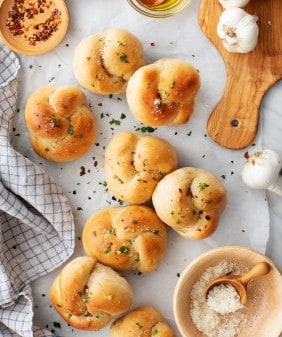
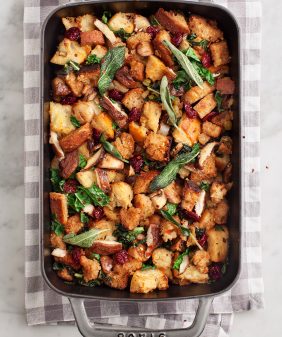


I adapted this recipe for high altitude (6,500 ft) by adding 2 extra tablespoons of both water and flour, 25% less yeast, doing the first rise in the fridge, and baking at 445 F instead of 425 F for just over 20 minutes. It turned out wonderful! So happy that it worked out even with the needed altitude adjustments 🙂
How would I make this without a stand mixer?
Absolutely delicious, this turned out amazing. I weighed my flour and hand mixed, and topped it with flaky sea salt and Italian herbs. This is the easiest and tastiest bread recipe I’ve found.
The best recipe! Easy to follow with perfect results. A winner in this house tonight. Thank you!
Worked perfectly. Question…can this be proofed overnight?
This didn’t work. 4 cups of flour seemed like WAY too much. It id not turn out sticky and wet in the mixer. I got this very firm mound of dough.
can i use bread flour in place of all purpose?
Thank you! My grandma is 90 and is a foodie like myself. I’m a chef but knew little of baking.. this was helpful. Came out better than a restaurant and she’s happy with fresh bread. Easy enough to remember after one try. I appreciate it! And man.. is the dough hook essential. Couldn’t find mine and used a center mix attachment and that was rough.
My first time with this recipe. I used fresh basil instead of rosemary, it smelled so good !
I missed the step of butter and EVOO in the aluminium pan… It stuck ! But it tasted really good. Next time I’m using parchment paper or buy a non-stick pan. I do have a glass Anchor Hocking dish…(?)
Hi Christine, I’m so glad you enjoyed the focaccia! You could bake this in the glass dish, but I’d still use parchment or grease with butter to prevent sticking.
I used a glass 9×13 and buttered it first, as suggested, and then added the olive oil. It came out of the dish just fine using a spatula.
I’ve scewed the steps of this recipe up so many times and still the focaccia came out wonderful. PHEW!
It never lasts long, it’s so deliscious.
Hi Kitty, I’m so glad you love the recipe!
This recipe is fantastic! Made it just like the recipe called for, and the added pizza toppings and it was like a Detroit style pizza!! Perfect!!
Every time I make this my dough is super shaggy and dry. Certainly not too sticky to transfer by hand. It tastes pretty good still. What am I doing wrong?
Hi Taylor, it sounds like there’s too much flour – are you weighing your flour?
The 500 G should be closer to 2 cups. I made the same mistake. Weighing helps a lot.
I always weigh! I also notice that even when weighing, if I pile the flour up in the middle of the bowl on the scale, it reads a few more grams more than if I push it out to the sides of the bowl to make a level, not heaped surface. It too makes a difference. Baking is science, cooking is art. Bon apatite.
Are you supposed to sift the flour or take it straight from the container???
Vickie
Hi Vickie, we don’t sift it, but we do weigh it here. If you don’t have a kitchen scale, we use this spoon and level method to measure the flour: https://www.loveandlemons.com/how-to-measure-flour/
Kasi, one cup of all-purpose flour, weighs 120 grams, so 4 cups = 480 grams, which has been rounded up to 500 grams in this recipe. Also, if you aren’t going to (or can’t) weigh the flour, it should be gently spooned into the cup to not compress the flour. If the flour is scooped straight from the bag or canister into a measuring cup, it will add more flour than is needed and may produce a dry dough.
This turned out so well!!! Playing with oven time not my favorite lol But I will have to make this again!
I’m so glad it worked out well!
So simple to follow and absolutely delish!
I’m so glad you loved it!
Trying this today! Going to first rise now. But I want to bake later today so what should I do after the first rise? I don’t want to bake for another 4 hrs or so.
I refrigerate dough after 1st rise. Take out 2 hours before baking for 2nd rise. It works with my pizza dough and this recipe is about the same as mine
Deeee-licious!! I split the dough into 2 “pieces” after the first rising into two 9×9 pans. One is for now and one for the freezer (as you say, reheats nicely in the oven). YUM!!
Hi Julia, so glad you loved it!
I just made this with rosemary and cherry tomatoes and omg <3 thank you so much for sharing this recipe. I was nervous I may not have done my dough right, but it’s fantastic. The crust on it, the fluffy inside, I did good <3
Do you take it out of Pam for cooling or leave it in Pan?
Hi Megan, I typically leave it in the pan for about 10 minutes and then transfer it to a wire rack.
I’ve used a couple other recipes that had quicker times, but were inconsistent. This recipe is fast, easy, and always yum results.
I’m so glad you’ve loved it!
Holy Mother Mary, this recipe is AMAZING. I followed it exactly besides adding cheese to the top. I’ll make it again soon because I want to make sure I can replicate it when I need to impress my retired chef family members, lol. Thank you for the ego and joy boost. Freakin gold, man.